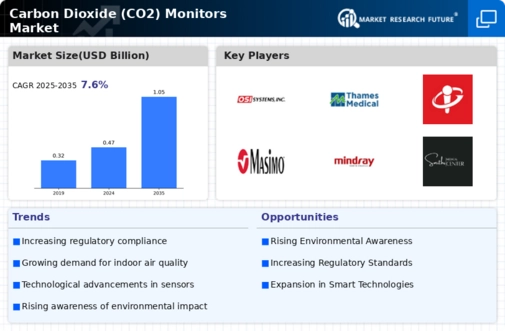Top Industry Leaders in the Carbon Dioxide Monitors Market

The Competitive Landscape of the Carbon Dioxide Monitor Market
From bustling factories exhaling industrial fumes to verdant greenhouses pulsating with plant life, across sterile hospital wards and bustling classrooms, an unseen conductor orchestrates the dance of gases – the Carbon Dioxide (CO2) monitor. This dynamic market pulsates with the competitive energy of players vying for control over these silent guardians of air quality. Unveiling the strategies, crucial factors, and overall landscape of this intricate market is vital for navigating its currents and securing a leading position.
Some of the Carbon Dioxide (CO2) Monitors companies listed below:
- Dräger Medical GmbH
- Medtronic PLC
- OSI Systems Inc.
- Thames Medical
- Criticare Systems Inc.
- GE Healthcare
- Invivo
- Masimo
- Mindray North America
- Nihon Kohden Corporation
- Nonin Medical Inc.
- Philips Healthcare
- Radiometer Medical ApS
- Smiths Medical
Strategies Adopted by Leaders:
- Technological Prowess: Vaisala and GE Analytical Instruments lead the charge with advanced NDIR (Non-Dispersive Infrared) and electrochemical CO2 sensor technologies boasting high accuracy, fast response times, and minimal calibration needs, catering to stringent monitoring requirements across diverse applications.
- Vertical Specialization: MSA Safety and Honeywell Analytics focus on specific segments like worker safety in confined spaces or environmental monitoring in agriculture, achieving unmatched expertise and cost-effectiveness within their chosen domains.
- Portable and Remote Monitoring Solutions: Companies like RKI Instruments and Graywolf Sensing offer compact, battery-powered CO2 monitors ideal for field measurements, remote data logging, and on-the-go air quality checks.
- Data Connectivity and Cloud Integration: Emerson and Siemens offer CO2 monitoring systems seamlessly integrating with building management systems and cloud platforms, enabling real-time data visualization, automated alarms, and remote monitoring capabilities.
- Focus on User Experience and Ease of Use: Companies like Amphenol Sensors and Telaire prioritize intuitive interfaces, clear data displays, and minimal training requirements, ensuring user acceptance and widespread adoption even in non-technical settings.
Critical Factors for Market Share Analysis:
- Accuracy and Sensor Technology: Companies offering CO2 monitors with high accuracy, minimal drift over time, and rapid response to changes in air quality command premium prices and secure market share by ensuring reliable data and timely safety interventions.
- Compliance with Regulations and Standards: Adherence to stringent safety regulations for confined space monitoring, environmental monitoring standards, and data privacy compliance is crucial for gaining trust and meeting legal requirements in diverse applications.
- Durability and Environmental Resilience: Monitors resistant to harsh environments, dust, and moisture, with robust calibration procedures, are crucial for long-term operation and reliable data in industrial settings or outdoor use.
- Connectivity and Data Management: Seamless integration with existing systems, secure data transmission, and user-friendly platforms for real-time analysis and historical data access are increasingly important for informed decision-making and comprehensive air quality management.
- Cost-Effectiveness and Affordability: Balancing advanced functionalities with an attractive price point is essential for capturing market share, particularly in price-sensitive segments like educational institutions or small businesses.
New and Emerging Companies:
- Startups like Airthings and Foobot: These innovators focus on developing smart home CO2 monitors and air quality sensors with sleek designs, mobile app integration, and personalized air quality insights, catering to growing consumer awareness and demand for healthy indoor environments.
- Academia and Research Labs: The University of California, Berkeley's Center for Environmental Research Technology and Massachusetts Institute of Technology's Senseable City Lab explore disruptive technologies like bio-inspired sensors, low-power wireless monitoring systems, and AI-powered air quality prediction algorithms, shaping the future of CO2 monitoring and environmental intelligence.
- Material Science Companies: DuPont and 3M invest heavily in R&D for advanced sensor materials with enhanced sensitivity, faster response times, and improved durability, enabling the development of next-generation CO2 monitors with superior performance and wider application potential.
Latest Company Updates:
Nov. 11, 2023- GHGSat (Canada), an emissions monitoring company, launched a satellite, Vanguard, to detect carbon dioxide emissions from facilities like coal plants and steel mills from space for the first time. Space-age technology is increasingly used to hold polluting industries accountable for their contributions to climate change. Launched from Vandenberg Space Force Base in California, Vanguard is available to industrial emitters, governments, and scientists who want to reduce their emissions.
Nov. 09, 2023- Kidde Safety Europe, a leading manufacturer of safety alarms and equipment, launched a new CO2 monitor to help people understand and improve indoor air quality in homes, workplaces, schools and hospitality venues. This new non-dispersive infrared (NDIR) monitor complies with the Scottish Building Standards requirements for mandatory CO2 monitors.
Sep. 06, 2022- CO2Meter Inc., a leading global gas detection, monitoring, and analytical device provider, launched a new, wall-mounted dual-sensor indoor CO2 grow controller, RAD-0502. This dual-sensor CO2 controller for grow rooms can monitor and control CO2 concentrations. This highly anticipated dual-sensor CO2 grow controller will allow indoor growers and mushroom farmers to control consistent CO2 levels throughout their grow space from a central display panel.
Nov. 12, 2020- UK-based Teledyne e2v's space imaging division announced completing Thales' Alenia Space contract to supply a specialized image sensor for CO2I and NO2 instruments. As the sensor partner for Thales Alenia Space, Teledyne's UK team will develop, manufacture and supply variants of their Capella CMOS visible image sensor from Chelmsford. The company will supply image sensors and detectors to the recently announced proposal of the European Space Agency to place six Copernicus Sentinel satellite missions in space.
